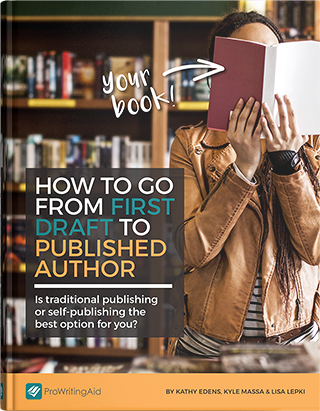
The quick answer is – no! The beauty of self-publishing is that you can do whatever you want. But, as a self-published author, I find a synopsis very helpful. For me, it’s a multi-purpose tool I refer to at all stages of novel writing.
There is a lot of advice online regarding the specifics of a synopsis. One thing that everyone seems to agree on is your synopsis should include all the major plot points of your novel, especially the ending. Agents and publishers won’t know if they’re interested in your work without knowing how your story ends.
Some agents and publishers will ask for a one-page synopsis, or a synopsis no longer than 500 words. When you have a set of guidelines to follow, it’s easy to write to fit those guidelines and then look no further. I think this is the wrong way to go, and being self-published frees me from any word count restrictions.
I like to work with a two-page synopsis when I’m writing. Any shorter and my process definitely wouldn’t run as smoothly. If you’re following the guidelines for a traditional path to publishing, you may want to have a couple of versions of your synopsis ready – one that fits the guidelines, and one you can really work with.
Here are five ways I use a synopsis as a self-published author.
Use 1: Get the Basics Down
I like to write a synopsis before I draft my book. It helps me figure out if my ideas have any weight by free-writing around my story idea. Google Docs is the first place I start, but you can handwrite this if it helps your ideas flow. Then I edit this free writing into a two-page synopsis, aiming to see the middle of my book happen at the end of page one.
When I’m writing this, I think of my audience as an agent or publisher, so I try to include all the key pieces of the story they might look for as well as small descriptions of the main characters and setting. I’m the kind of writer that likes to know the end of my book before I start, so I make sure this is included as well.
Sometimes, I will send my synopsis to an editor for feedback before I write my book. Many editors offer this kind of feedback as a service. The synopsis I write for myself does not differ from what I would write for an agent or a publisher. This is perfect if I decide later I’d like to find a traditional publisher for the book.
Use 2: Save Time and Money on Editing
Not all writers will agree with me here, but I attended a webinar taught by Tex Thompson last year and she suggested having an editor review your synopsis before writing your novel to gain clarity on your project and potentially save money on editing costs down the road. It worked fantastically.
I had Tex review my synopsis, and we had such a fabulous discussion around it I came away from our call with clarity regarding where the plot was going and a fresh idea for a twist at the end. I did the same thing for my synopsis of my book Unaudited. Margo Dill of Editor 911 had edited another book in my series, so she knew the right questions to get me thinking more critically about my plot.
If you’ve got the major elements of your story tied down with the help of an editor, these areas will need less work later on. Instead, you can focus on completing an extensive self-edit on your book as soon as you’ve finished writing it. Use ProWritingAid to catch and fix small (but important!) issues like overused words, unruly dialogue tags and pacing issues in your manuscript.
If you decide to send it off to an editor for a final check, they’ll be able to focus on bigger areas like characterization and story arc rather than grammar mistakes and distracting turns of phrase.
Use 3: Analyze for Further Plot Expansion
I’m a very lean writer, which means my first drafts are always way too short and lack a lot of description of the setting and characters. A synopsis can help a writer see where they need to flesh out their plot, whether they have an editor help them do this or take a critical look at it for themselves.
Sometimes setting a synopsis aside for a week or two, like you would the first draft of your novel, can help you see where you need to beef the plot up to keep it going through that dreaded sagging middle.
A synopsis can be used as an outline or a starting point for an outline, depending on how detailed you like to get before writing your novel. Generally, a synopsis hits all the key points in your story. From here, you can ask yourself what needs to happen for the characters to get from one plot point to the next. This can lead to notes for individual scenes in your book.

Use 4: Share Your Ideas with Cover Designers
If you are going to have a book cover custom designed for your book, a synopsis can be a useful tool to ensure you get a design that suits your book. Cover designers like Tugboat Design that offer personalized pre-made cover options require a one-page synopsis as part of their intake forms.
Starting with your two-page synopsis, it’s easy to pick the key points in your story and edit that down to one page, especially if you know you’re doing it to provide useful information for your cover designer to use when creating a cover concept for your book.
Use 5: Pick the Best Parts for Promo
Once you’ve edited your two-page synopsis down to one page, you can edit it even further to pull out the most interesting parts of the story for your tagline, back cover copy, and any other copywriting you’ll create for your book. The synopsis should already include the key plot points, main characters, and an overall theme.
I enjoy writing the synopsis, tagline, and back cover copy before I draft a novel, because I find it much easier to work with 1,000 or so words than the 60k-80k or more that a novel includes. Some authors would say this is backwards, but for me, it’s easier to write these shorter pieces first, then tweak them later if the novel turned out drastically different from what I’d planned.
Takeaways
So, when I think of all the things you can use a synopsis for – outlining, editing, plot expansion, cover design, and marketing – my answer to the question, “Do you need a synopsis when you self-publish?” is a very emphatic YES! I would be lost without one, but we each have our own process and part of the fun of writing is determining what works best for you.


